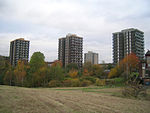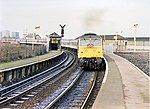Queen's Park Hippodrome
1904 establishments in EnglandBuildings and structures demolished in 1966Theatres in Manchester
The Queen's Park Hippodrome was a theatre in Harpurhey, Manchester, England. It was built on the site of an old tramshed and opened on 25 April 1904. It initially staged variety, dramas, pantomimes, and revues, which gave way to "sizzlingly saucy" French variety acts towards the end of the theatre's life.Like many other theatres of the period, the increasing competition from cinema resulted in its closure in 1952, and the building was eventually demolished in 1966.The theatre was part of the Broadhead Circuit of 17 theatres at its peak, which had its head quarters at Hulme Hippodrome.
Excerpt from the Wikipedia article Queen's Park Hippodrome (License: CC BY-SA 3.0, Authors).Queen's Park Hippodrome
Kelvington Drive, Manchester Collyhurst
Geographical coordinates (GPS) Address Nearby Places Show on map
Geographical coordinates (GPS)
| Latitude | Longitude |
|---|---|
| N 53.504185 ° | E -2.216168 ° |
Address
Kelvington Drive
Kelvington Drive
M9 5QW Manchester, Collyhurst
England, United Kingdom
Open on Google Maps






